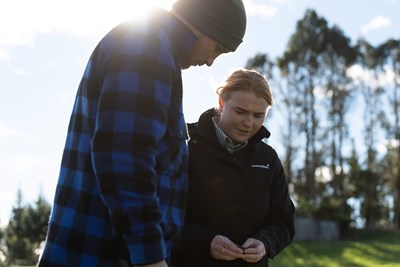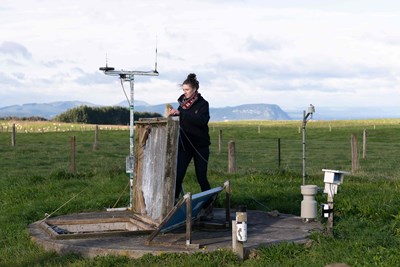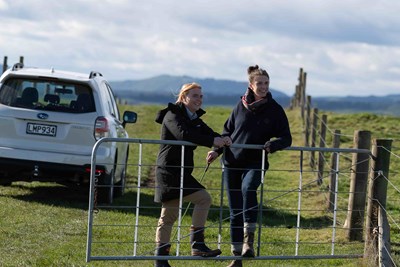Monday, 9 August 2021
Walking the path less trodden
A risk-averse lending sector and carbon farming sales have left many of our younger generation with limited options for farm ownership. But tenacity, determination and good old-fashioned hard work have seen a young couple buy their first farm on the shores of Lake Taupō . Ravensdown shareholders Sean Nixon and Ruby Mulinder talk Ravensdown through the process of first-farm purchase, running a smart sheep and beef system in a nutrient sensitive catchment, and their venture into sheep milking.
The path to farm ownership for Sean Nixon and Ruby Mulinder has been hard graft. But now they’re across the line they’re working hard to create a profitable operation while still working their day jobs off farm.
Sean grew up on a support block that was part of a family dairy business at Ngakuru. He studied chemical engineering at the University of Waikato, worked as a process engineer in the dairy industry in both New Zealand and the UK, and then ventured out on his own when he returned to New Zealand in 2017. Ruby grew up in Central Hawke’s Bay where she was exposed to a wide range of farming systems, setting the direction for a future in the agricultural sector. After completing a Bachelor of Agricultural Science at Massey University, she worked at Landcorp Pastoral where she was involved in dairy farm conversions between Taupō and Reporoa. She followed with two years in the UK dairy industry and more recently has been working as a FarmWise consultant in South Waikato, specialising in dairy, sheep dairy, land use feasibility and group facilitation.
The couple arrived home from the UK with farm ownership on their minds. Their interest in sheep milking had grown and they wanted a farm that could suit that system – an older dairy farm with a small shed or a sheep and beef farm that could be converted. Sean says they were investigating a block on the western side of Lake Taupō when a friend suggested they talk to Mike and Sharon Barton, founders of Taupō Beef, about farming in the Lake Taupō catchment. “Ultimately we decided not to put an offer in on that [initial] block, but a month after that Ruby got a phone call from Mike saying he’d been thinking about selling and would we be interested in looking at their block. It just went from there – the farm was a bit bigger than what we had initially considered, but we managed to structure a deal with the bank that eventually got it over the line.”
Sean says one of the positives is that the size of the block has given them more scope. “If we’d bought a smaller block of 50ha, it would have been a five-to-ten-year maximum property. This property gives us options because it’s that much bigger.”
Getting across the line
Ruby describes the process of borrowing without a large amount of equity as incredibly difficult, even though the budgets stacked up. It was right when rural lending had dried up, and Sean says the fact they weren’t actively farming made things difficult. “An interesting concern of the banks was that we hadn’t actually been farming full time,” he says. “But if I had been working as a shepherd, I would never have been in the position to buy a farm … we were better off working our professional careers and then making the move to farming, so that was kind of ironic in a way.”
Ruby says it’s worth people realising that even if you work your way up to management level, getting to ownership is still very difficult. “We’ve both been squirrels which is how we've got to this position, living within our means and saving as much as we could [as well as] working two off-farm jobs.”
The farm is 142ha, with 20ha retired and planted out in a mix of Douglas fir and natives. They lease 8ha from their neighbours, balancing out to 130ha effective. They are 100% permanent pasture but are open to looking at more summer-safe options such as cropping in the future. They farm 70ha of flat and 60ha hill country, which Ruby says provides an awesome balance for lambing ewes, providing shelter over the early spring period. “When we walked around the farm before we purchased it, the balance of flat and sheltered north-facing hill was a real plus for us.”
They winter 1,550 stock units, a mix of sheep and beef. They run 670 ewes, and as they transition to a sheep-dairy model are considering the right balance of cattle for the property. Prior to purchase the farm hadn’t run sheep for more than 20 years. “Having the balance of sheep and cattle has dramatically improved our pasture management. We run an intensive rotational grazing system with our cattle which are on daily shifts all year round, enabling us to drive intakes, protect our soils and manage pasture residuals. Being able to utilise the ewes to help tidy up pasture has been a great way to redistribute nutrients more evenly,” Ruby says. Their current policy focuses on buying weaners and finishing everything by 20 months of age as it works from a nitrogen leaching perspective. They supply Taupō Beef and Lamb, and this season they’re on track to do 395kg CW/ha. “That’s something that we've been exploring – challenging the system to find where the best margin lies for us and how it works practically with the sheep dairy model,” says Ruby.
Their initial focus has been on improving the farm’s pasture quality. Soils are pumice-based light volcanic sandy loams with good levels of topsoil. The flat country is cocksfoot and clover dominant with brown top, native grasses and limited clover on the hillsides. They take a critical thinking approach to nutrients and fertility, using OverseerFM for scenario planning. This is particularly important as the Taupō catchment has a nitrogen discharge allowance (NDA), which means both inputs and stocking rates are effectively capped. They are careful to keep their N use low and strategic at 20kg/ha/year on average over the whole farm. “In spring we use a little bit of N to kick us off and bridge the gap between winter and spring,” says Sean.
They are mindful of soil acidification and the roll-on impacts of different fertilisers, particularly as they have experienced palatability problems on parts of the farm. “Lime is a key thing that we'll be doing every year, and [monitoring] our potassium levels to grow as much clover as we can,” says Sean. “In a red meat system clover is what makes money … basically the more legumes we can get into our animals, the better our milk and meat production will be.”
“Every nutrient we put on we want to be utilised and grow more palatable grass,” says Ruby. “We’re trying to optimise our soil health and not become reliant on nitrogen.”
Sean says they’ve been using HawkEye® to order and monitor fertiliser applications and map their farm. “I'm starting to add other features of the farm to the map layers, so if someone's coming in to look after the farm, I can have it marked up nicely on HawkEye rather than the old original farm map from when it was surveyed off.”
“It’s an awesome tool … really helpful,” says Ruby.
A hands-on approach
Animal welfare is a central pillar for the couple, and they base their system around ensuring their stock maintain condition. Animals are on a daily shift, even in winter, to limit any pugging and maximise regrowth time.
“Our whole mentality on the farm is to keep stock moving. The farm is managed pretty intensively considering we both work other jobs,” says Ruby. “It has to be,” continues Sean. “The block is too small to have any sort of dilution. To try and make money off it we need to manage it quite intensively with good attention to detail.”
The sheep milking gave them the option to diversify and walk a path less trodden. Initially it was still very niche, so the challenge would have been processing the product and marketing it themselves.
“There are not many farming businesses where you can end up being a farmer, marketer and a processor and do it successfully, particularly from a time perspective,” says Sean. “When [sheep milking operations] Maui Milk and Spring Sheep began offering supply contracts, that changed the pathway and made things clear-cut.” The couple has signed a contract with Maui Milk and will begin supply in spring. “The real appeal is that it remains a sheep and beef system, which we like,” Sean says “And because milking sheep is quite different to milking cows – there's no real cookie cutter way to do it – we can set up our own system. Ultimately, on a farm this size, it makes it more economically viable.”
About 50-60% of income will come from milk and the balance from beef and lamb. “It’s based around a wholesome food story really – nothing is a by-product,” says Ruby. “It's not solely economic, but it’s still a big part because we need to improve our EBIT [earnings before interest and tax] so we can get to a position that we're not 90 years old and still servicing debt.”
Sean describes their flock as a ‘mish-mash’ commercial base with dairy breeds being first introduced six years ago. Following the arrival of new milking genetics from Europe, they have started using French milking breed Lacaune and UK genetics to improve milk yields and udder confirmation in their flock. “We are focussing on breeding our own dairy composite where we select the traits that suit our system,” says Sean. “We're trying to breed a different sheep to most other sheep dairy operations,” continues Ruby. “Our key focus is the ewe is a good mum and is able to rear her lambs – we don’t have the ability or budget to have four labour units driving out to rear 1,000 lambs.”
The ewes will rear their lambs up until early weaning. Post-weaning the lambs will stay on meal and ideally be finished on farm. The ewes will then be milked twice a day from September through to April. The farm is in the conversion phase, with equipment being put together off site to avoid travel costs. When set up, it will be a 30-a-side, rapid exit herringbone parlour with swing-over cups, suitable to be run efficiently by a sole operator. The initial stages will see Sean and Ruby operate a twice-a-day model, but longer term they would like to explore once a day.
“We are trying to find that right balance of per ewe productivity and labour demand as the genetics coming in from Europe do not entirely suit an outdoor New Zealand system,” Sean says. “They don't have the robust conformation or the constitution for it so there's going to be a fair bit of selection pressure in the coming generations of sheep.”
“We're just sticking to our guns on what we want,” says Ruby. “We're not going to end up with the equivalent of the 500kgMS cow, but something that works in our system as well as valuing the lamb.”





